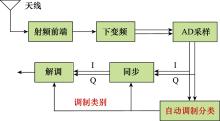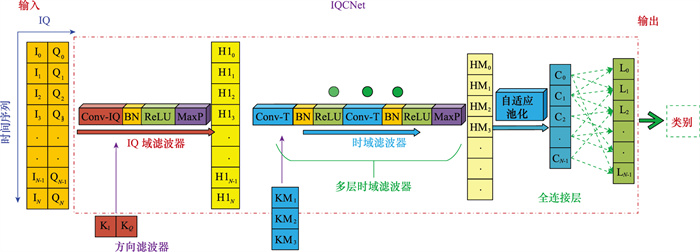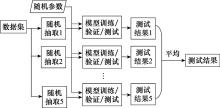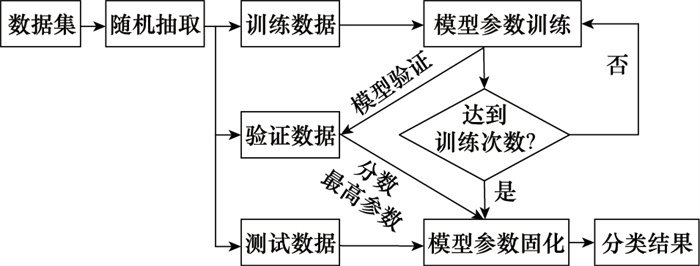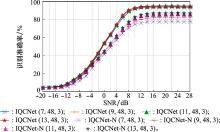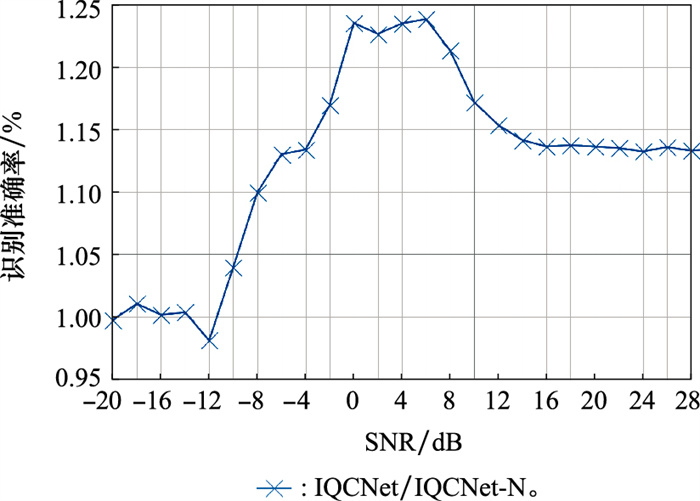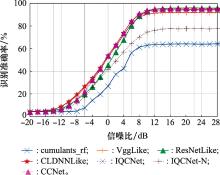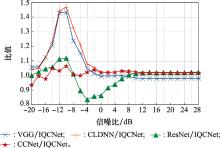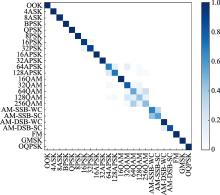Systems Engineering and Electronics ›› 2023, Vol. 45 ›› Issue (7): 2220-2226.doi: 10.12305/j.issn.1001-506X.2023.07.33
• Communications and Networks • Previous Articles Next Articles
Automatic modulation classification based on lightweight network for space cognitive communication
Tianshu CUI1, Dong WANG2, Zhen HUANG1,*
- 1. Beijing National Researh Center for Information Science and Technology (BNRist), Tsinghua University, Beijing 100190, China
2. School of Computer Science and Technology, University of Chinese Academy of Sciences, Beijing 100149, China
-
Received:2022-05-14Online:2023-06-30Published:2023-07-11 -
Contact:Zhen HUANG
CLC Number:
Cite this article
Tianshu CUI, Dong WANG, Zhen HUANG. Automatic modulation classification based on lightweight network for space cognitive communication[J]. Systems Engineering and Electronics, 2023, 45(7): 2220-2226.
share this article
Table 2
Automatic modulation classification dataset"
| 数据集 | RadioML |
| 数据格式 | 1 024×2 |
| SNR/dB | [-20:2:30] |
| 调制类型数量 | 24 |
| 模拟调制 | FM, AM-SSB-SC, AM-SSB-WC, AM-DSB-WC, AM-DSB-SC, |
| 数字调制 | OOK, OQPSK, GMSK, BPSK, QPSK, 8PSK, 16PSK, 4ASK, 8ASK, 16APSK, 32APSK, 64APSK, 128APSK, 32PSK, 16QAM, 32QAM, 64QAM, 128QAM, 256QAM |
| 样本数据量 | 24×26×4 096=2 555 904 |
| 1 |
BANERJEE S , SANTOS J , HEMPEL M , et al. A novel method of near-miss event detection with software defined radar in improving railyard safety[J]. Safety, 2019, 5 (3): 55.
doi: 10.3390/safety5030055 |
| 2 | SMITH A, EVANS M, DOWNEY J. Modulation classification of satellite communication signals using cumulants and neural networks[C]//Proc. of the Cognitive Communications for Aerospace Applications Workshop, 2017. |
| 3 | SILLS J A. Maximum-likelihood modulation classification for PSK/QAM[C]//Proc. of the Military Communications Conference, 1999. |
| 4 |
WEI W , MENDEL J M . Maximum-likelihood classification for digital amplitude-phase modulations[J]. IEEE trans.on Communications, 2000, 48 (2): 189- 193.
doi: 10.1109/26.823550 |
| 5 | HONG L, HO K C. Identification of digital modulation types using the wavelet transform[C]//Proc. of the Military Communications Conference, 1999. |
| 6 |
SWAMI A , SADLER B M . Hierarchical digital modulation classification using cumulants[J]. IEEE Trans.on Communications, 2000, 48 (3): 416- 429.
doi: 10.1109/26.837045 |
| 7 | HATZICHRISTOS G, FARGUES M P. A hierarchical approach to the classification of digital modulation types in multipath environments[C]// Proc. of the 35th Asilomar Conference on Signals, Systems and Computers, 2001. |
| 8 | KRIZHEVSKY A, SUTSKEVER I, HINTON G E. Imagenet classification with deep convolutional neural networks[C]//Proc. of the 25th International Conference on Neural Information Processing Systems, 2012. |
| 9 | ARISOY E, SETHY A, RAMABHADRAN B, et al. Bidirectional recurrent neural network language models for automatic speech recognition[C]// Proc. of the IEEE International Conference on Acoustics, Speech and Signal Processing, 2015: 5421-5425. |
| 10 | ZHANG M , DIAO M , GUO L M . Convolutional neural networks for automatic cognitive radio waveform recognition[J]. IEEE Access, 2017, (5): 11074- 11082. |
| 11 | 周鑫, 何晓新, 郑昌文. 基于图像深度学习的无线电信号识别[J]. 通信学报, 2019, 40 (7): 114- 125. |
| ZHOU X , HE X X , ZHENG C W . Radio signal recognition based on image deep learning[J]. Journal on Communications, 2019, 40 (7): 114- 125. | |
| 12 |
QU Z Y , WANG W Y , HOU C B , et al. Radar signal intra-pulse modulation recognition based on convolutional denoising autoencoder and deep convolutional neural network[J]. IEEE Access, 2019, 7, 112339- 112347.
doi: 10.1109/ACCESS.2019.2935247 |
| 13 |
PENG S L , JIANG H Y , WANG H X , et al. Modulation recognition using hierarchical deep neural networks[J]. IEEE Trans.on Neural Networks and Learning Systems, 2019, 30 (3): 718- 727.
doi: 10.1109/TNNLS.2018.2850703 |
| 14 | SZEGEDY C, LIU W, JIA Y Q, et al. Going Deeper with Convolutions[C]//Proc. of the IEEE Conference on Computer Vision and Pattern Recognition, 2015. |
| 15 |
HOCHREITER S , SCHMIDHUBER J . Long short-term memory[J]. Neural Computation, 1997, 9 (8): 1735- 1780.
doi: 10.1162/neco.1997.9.8.1735 |
| 16 | O'SHEA T J, CORGAN J, CLANCY T C. Convolutional radio modulation recognition networks[C]//Proc. of the International Conference on Engineering Applications of Neural Networks, 2016: 213-226. |
| 17 | WEST N E, O'SHEA T. Deep architectures for modulation recognition[C]//Proc. of the IEEE International Symposium on Dynamic Spectrum Access Networks, 2017. |
| 18 | SAINATH T N, VINYALS O, SENIOR A, et al. Convolutional, long short-term memory, fully connected deep neural networks[C]//Proc. of the IEEE International Conference on Acoustics, Speech and Signal Processing, 2015: 4580-4584. |
| 19 |
O'SHEA T J , ROY T , CLANCY T C . Over-the-air deep learning based radio signal classification[J]. IEEE Journal of Selected Topics in Signal Processing, 2018, 12 (1): 168- 179.
doi: 10.1109/JSTSP.2018.2797022 |
| 20 | SIMONYAN K, ZISSERMAN A. Very deep convolutional networks for large-scale image recognition[EB/OL]. [2022-04-14]. https://arxiv.org/abs/1409.1556 . |
| 21 | HE K, ZHANG X, REN S, et al. Deep residual learning for image recognition[C]//Proc. of the IEEE Conference on Computer Vision and Pattern Recognition, 2016: 770-778. |
| 22 | KRZYSTON J, BHATTACHARJEA R, STARK A. Complex-valued convolutions for modulation recognition using deep learning[C]//Proc. of the IEEE International Conference on Communications Workshops, 2020. |
| 23 | 崔天舒, 崔凯, 黄永辉, 等. 卷积神经网络卫星信号自动调制识别算法[J]. 北京航空航天大学学报, 2022, 48 (6): 986- 994. |
| CUI T S , CUI K , HUANG Y H , et al. Convolutional neural network satellite signal automatic modulation recognition algorithm[J]. Journal of Beijing University of Aeronautics and Astronautics, 2022, 48 (6): 986- 994. | |
| 24 | IANDOLA F N, HAN S, MOSKEWICZ M W, et al. SqueezeNet: AlexNet-level accuracy with 50x fewer parameters and < 0.5 MB model size[EB/OL]. [2022-04-14]. https://arxiv.org/abs/1602.07360 . |
| 25 | CHOLLET F. Xception: deep learning with depthwise separable convolutions[C]//Proc. of the IEEE Conference on Computer Vision and Pattern Recognition, 2017: 1251-1258. |
| 26 | HOWARD A G, ZHU M, CHEN B, et al. Mobilenets: efficient convolutional neural networks for mobile vision applications[EB/OL]. [2022-04-14]. https://arxiv.org/abs/1704.04861 . |
| 27 | ZHANG X, ZHOU X, LIN M, et al. Shufflenet: an extremely efficient convolutional neural network for mobile devices[C]// Proc. of the IEEE Conference on Computer Vision and Pattern Recognition, 2018: 6848-6856. |
| 28 | 黄知涛, 周一宇, 姜文利. 基于相对无模糊相位重构的自动脉内调制特性分析[J]. 通信学报, 2003, (4): 153- 160. |
| HUANG Z T , ZHOU Y Y , JIANG W L . The automatic ana-lysis of intrapulse modulation characteristics based on the relatively non-ambiguity phase restoral[J]. Journal of China Institute of Communications, 2003, (4): 153- 160. | |
| 29 |
IGLESIAS V , GRAJAL J , ROYER P , et al. Real-time low-complexity automatic modulation classifier for pulsed radar signals[J]. IEEE Trans.on Aerospace and Electronic Systems, 2015, 51 (1): 108- 126.
doi: 10.1109/TAES.2014.130183 |
| 30 | 崔天舒. 面向天基电磁信号识别的深度学习方法[D]. 北京: 中国科学院大学(中国科学院国家空间科学中心), 2021. |
| CUI T S. Deep learning methods for space-based electromagnetic signal recognition[D]. Beijing: University of Chinese Academy of Sciences (National Space Science Center, Chinese Academy of Sciences), 2021. | |
| 31 | O'SHEA T J, WEST N. Radio machine learning dataset ge-neration with gnu radio[C]//Proc. of the GNU Radio Confe-rence, 2016. |
| [1] | Yu JIANG, Qi YUAN, Zhitao HU, Weiwei WU, Xin GU. Airport arrival and departure delay time prediction based on meteorological factors [J]. Systems Engineering and Electronics, 2023, 45(6): 1722-1731. |
| [2] | Yang CHEN, Canhui LIAO, Kun ZHANG, Jian LIU, Pengju WANG. A signal modulation indentification algorithm based on self-supervised contrast learning [J]. Systems Engineering and Electronics, 2023, 45(4): 1200-1206. |
| [3] | Ye ZHANG, Yi HOU, Kewei OUYANG, Shilin ZHOU. Survey of univariate sequence data classification methods [J]. Systems Engineering and Electronics, 2023, 45(2): 313-335. |
| [4] | Zhengtu SHAO, Dengrong XU, Wenli XU, Hanzhong WANG. Radar active jamming recognition based on LSTM and residual network [J]. Systems Engineering and Electronics, 2023, 45(2): 416-423. |
| [5] | Ruize LI, Shuanghui ZHANG, Yongxiang LIU. Computational efficient structural sparse ISAR imaging method based on convolutional ADMM-net [J]. Systems Engineering and Electronics, 2023, 45(1): 56-70. |
| [6] | Xiao HAN, Shiwen CHEN, Meng CHEN, Jincheng YANG. Open-set recognition of LPI radar signal based on reciprocal point learning [J]. Systems Engineering and Electronics, 2022, 44(9): 2752-2759. |
| [7] | Limin ZHANG, Kaiwen TAN, Wenjun YAN, Yuyuan ZHANG. Radar emitter recognition based on multi-level jumper residual network [J]. Systems Engineering and Electronics, 2022, 44(7): 2148-2156. |
| [8] | Guodong JIN, Yuanliang XUE, Lining TAN, Jiankun XU. Advances in object tracking algorithm based on siamese network [J]. Systems Engineering and Electronics, 2022, 44(6): 1805-1822. |
| [9] | Xiaofeng ZHAO, Yebin XU, Fei WU, Jiahui NIU, Wei CAI, Zhili ZHANG. Ground infrared target detection method based on global sensing mechanism [J]. Systems Engineering and Electronics, 2022, 44(5): 1461-1467. |
| [10] | Hong ZOU, Chenyang BAI, Peng HE, Yaping CUI, Ruyan WANG, Dapeng WU. Edge service placement strategy based on distributed deep learning [J]. Systems Engineering and Electronics, 2022, 44(5): 1728-1737. |
| [11] | Dong CHEN, Yanwei JU. Ship object detection SAR images based on semantic segmentation [J]. Systems Engineering and Electronics, 2022, 44(4): 1195-1201. |
| [12] | Jingming SUN, Shengkang YU, Jun SUN. Pose sensitivity analysis of HRRP recognition based on deep learning [J]. Systems Engineering and Electronics, 2022, 44(3): 802-807. |
| [13] | Yunxiang YAO, Ying CHEN. Target tracking network based on dual-modal interactive fusion under attention mechanism [J]. Systems Engineering and Electronics, 2022, 44(2): 410-419. |
| [14] | Yongxing GAO, Xudong WANG, Ling WANG, Daiyin ZHU, Jun GUO, Fanwang MENG. Weather signal detection for dual polarization weather radar based on RCNN [J]. Systems Engineering and Electronics, 2022, 44(11): 3380-3387. |
| [15] | Yiheng ZHOU, Jun YANG, Saiqiang XIA, Mingjiu LYU. Estimation method of micro-motion parameters for rotor targets under flashing [J]. Systems Engineering and Electronics, 2022, 44(1): 54-63. |
| Viewed | ||||||
|
Full text |
|
|||||
|
Abstract |
|
|||||
